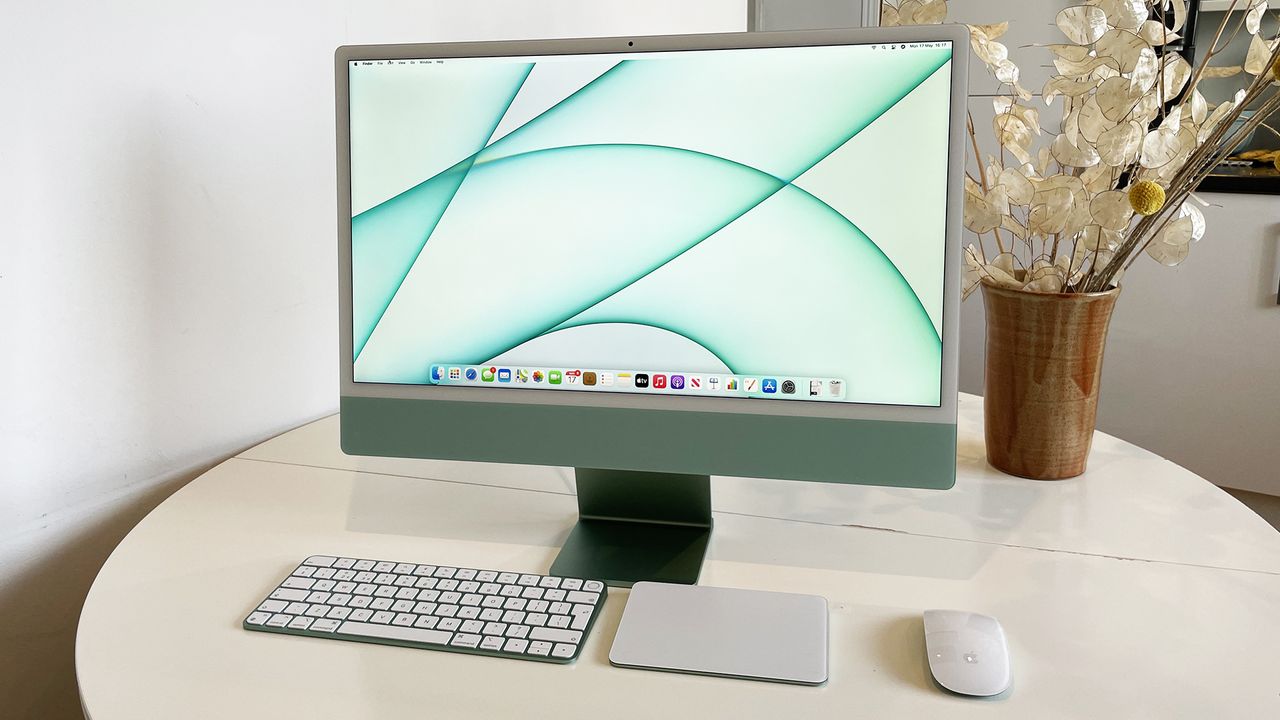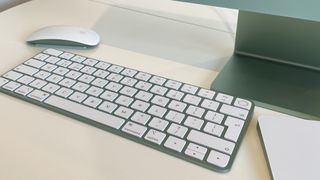Apple iMac 24-inch (2021) review: the world's coolest desktop
The new iMac 24-inch is a great-looking machine with a fantastic screen and lots of power… but some limitations, too

The iMac 24-inch is a great home or work machine, and has the power and screen for some pro work as well. But lower-price machine doesn't offer quite the full experience, and it's awkward for ports.
-
+
Fantastic better-than-4K screen
-
+
Beautiful design and colours
-
+
Extremely fast
-
-
Cheapest version is missing some features
-
-
Only USB Type-C ports
-
-
GPU and maximum RAM may be limiting
Why you can trust T3

This Apple iMac 24-inch (M1, 2021) review is the first time we've been able to judge what it's like when a Mac has been, in Apple’s words, “built from the ground up around M1”. With the MacBook Air (M1, 2020) and MacBook Pro 13-inch (M1, 2020), we got the new chip in the old computer design.
But the iMac 24-inch is all-new, internally and externally. The characteristics of Apple’s M1 chip means that the computer can be just 11.5mm thick, not including stand, but still pack in eight cores of potent processing power, and run silently in general use.
The 4.5K resolution screen is larger than the 21.5-inch model it replaces, but the whole unit is only 2cm wider and 1cm taller – and much less voluminous. It is, simply, much more computer in a smaller space… well, mostly.
There are a few changes in the iMac 24-inch that won’t be as welcome as the upgrades we’ve mentioned, and there’s one notable thing that hasn’t changed but really should have. But overall it’s maybe the most exciting Mac in years, and with its seven jaunty colours, it feels less like a new electronic appliance and more like a computer from the days when getting a new PC was cool and thrilling.
iMac 24-inch (2021) review: Price & release date
The iMac 24-inch is available from May 21st, 2021. It starts from £1,249/$1,299/AU$1,899, which gets you an M1 with an eight-core processor, seven-core GPU, 8GB RAM, 256GB storage, two USB Type-C/Thunderbolt 4 ports, and it’s available in green, pink, blue and silver. This version also doesn’t come with Touch ID fingerprint security on its keyboard, or an Ethernet port on its power brick.
If you step up to the £1,449/$1,499/AU$2,199 version, you get the M1 with an eight-core GPU, you get two additional USB Type-C ports (making four total), you get the keyboard with Touch ID, and you get the Ethernet port.
From here, you can customise the iMac 24-inch in two ways: RAM and storage. Neither can be upgraded in the future by the user, so you’ll need to buy right. The RAM can be upgraded to 16GB, but that’s the maximum. The storage can be raised from 256GB up to a maximum of 2TB.

iMac 24-inch (2021) review: Features & what's new
What’s new in the 24-inch iMac compared to the 21.5-inch model it replaces? Literally everything. Not a single aspect remains unchanged in some way.
Let’s start with the screen, which is a 23.5-inch, 4480x2520 display – Apple is calling this ‘4.5K’, which makes sense if you know that 4K just means ‘any screen around 4000 pixels wide’. This one has slightly more pixels. Easy! Apple has done 24-inch screens before, but not since 2009, so this is a blast from the past.
The screen offers 500 nits of typical brightness, and P3 wide colour gamut support both of which are big improvements on your average monitor, which is likely to be about half as bright, and without such wide colour support. You also get Apple’s True Tone system, which adjusts the colours based on the lighting in your room, and makes a big, big difference for eye comfort, in our experience.
The screen has always been one of the big draws for iMacs, because you don’t find a huge number of 21- to 24-inch 4K displays at all, let alone at this level of quality… and if you do, they cost most of what this entire machine costs, without adding all the actual computer parts.
For power, you’ve got the Apple M1 chip in an iMac for the first time, replacing the Intel processors and graphics used in the previous model. That’s an eight-core processor, with four high-power performance cores and four lower-speed 'efficiency' cores. You can get it with 8GB or 16GB of RAM – a drop from the 32GB max that the older model offered, which will be annoying for some pro users, though isn’t a problem for the average buyer.
The M1 also provides graphics, with seven or eight cores of GPU power depending on the model you choose. It also includes a ‘Neural Engine’, which can be used by apps that include machine learning tools to massively speed up tasks – this is niche, but some Mac apps are starting to make good use of it.
At the top is a 1080p Full HD webcam, which uses the M1 chip for image processing, though doesn’t include the useful ‘Center Stage’ feature that the iPad Pro (2021) does, disappointingly, which keeps you in the middle of frame even if you move around – Apple pushes this iMac as being as much for the kitchen or living room as an office desk, and this would be a really useful feature.
There’s also now a better array of mics that Apple describes as ‘studio-quality’, which will always remain as slightly wishful thinking when the average home office is lacking several other crucial qualities that studios have, but should still help to pick your voice and avoid other sounds around you.
The speakers are one of the most interesting upgrades. There are six drivers in total, with three in each of the bottom corners. The really clever part is the use of two woofers in each side, positioned exactly to oppose each other (one facing forward, one back). Force-opposing drivers are used to cancel out residual vibrations from powerful speakers, so you can put loud and impactful sound into something where you don’t want shaking to happen – they’re used in high-end subwoofers for home cinema, and in Apple’s 16-inch MacBook Pro, as well as here.
The concept of force-opposing speakers is that, because speakers need to move lots of air, and Newton’s Third Law exists, when you vibrate your driver in one direction to move air, there’s a resulting vibration that escapes into whatever holds the speaker. Big traditional speakers are made of wood because wood is good at absorbing these vibrations. In this case, you’d be able to feel powerful speakers in the desk. But if you have two speakers in opposition to each other, you have two sets of residual vibrations, which means they cancel each other out, so there’s almost no vibration in the end… yet you put in double the drivers! Big sound, small negative effect.
These are then paired with a dedicated high-end driver. In combination, it means a lot of speaker power, and Apple says it can create a ‘Spatial Audio’ effect, which is Apple name for 3D audio.
Finally, let’s talk connections. Other than the RAM, this is where you might think that things have gone backwards. Whichever version of the iMac you get (we detailed the main differences in the price section), you only get USB Type-C/Thunderbolt 4 ports, plus a 3.5mm headphones jack. No regular USB, no SD card reader, no regular HDMI port. You do get an Ethernet port on the more expensive model.
The reason appears to be simple: the body is too thin for them. The problem is also simple: if you’re replacing an existing iMac with this lovely new one and you have USB hard drives or other accessories, you’ll also need to buy a way to connect those peripherals to this machine.
In principle, we don’t mind Apple moving ahead with its all-USB-C future, it’s just frustrating that there’s no hub or solution to this problem that’s actually as good-looking as the iMac itself. You get a sleek computer, and then you might need to drastically un-sleek it.
The iMac supports up to Wi-Fi 6 for connectivity (802.11ax and before), and includes Bluetooth 5.0 too.
In the box, you get the keyboard and mouse or trackpad (your choice) in matching colour to your iMac colour choice. Pleasingly, the included USB-C to Lightning cable (for charging the mouse and keyboard) is colour-coded too, with the same lovely braided finish as the power cable.
A quick note on the box itself, which is a really satisfying thing to unpack, and feels like an event as you reveal its secrets – it’s nice to have a little playfulness in the Apple unboxing experience.

iMac 24-inch (2021) review: Design & accessories
We’ve already talked about loving the overall look of the new iMac 24-inch, and especially the colours, and can see the main things you need to from the images, including how thin it is, but let’s get into some of the design nitty gritty that’s not so obvious.
Apple’s images don’t show this well, but the front chin of the iMac is actually made of glass, and is a seamless piece with the white bezels and actual screen above it. This means that there are effectively three different tones of the same colour on the machine – the dark aluminium colour used on the sides and back, the lighter aluminium colour used on the stand, and then the lightest version of the colour, on the glass.
I say the glass is the lightest, but it depends – being glass and slightly translucent, light bounces on and in it differently. This is most obvious the more strong that sunlight is. In darker settings, it looks closer to the stand’s hue.
The cables (the power cable, and the USB-C-to-Lightning cable) both have lighter versions of whatever colour you chose in their braiding, and are very fetching.
No assembly is required for the stand, and the lightness of the screen makes it really easy to adjust the angle, generally. Having said that, though, the base of the iMac isn’t especially good at holding itself still on smooth surfaces, so on a classic white Ikea desk, we found that trying to re-angle the screen usually meant a bit of accidental sliding around.
The keyboard, mouse and trackpad come in the same aluminium colour as the stand of the iMac, plus white to match the display bezel.
The keyboard is great – the short travel won’t satisfy those who can only love mechanical keyboards, but for everyone, it’s a great mix of requiring only a little pressure, offering clear feedback when pressed, and having a comfortable amount of travel. The size is good, too.
Having the Touch ID button in the top-right of the keyboard is something we’ve wanted for a long time, and it works perfectly – it’s absolutely instant whenever you use it.
Apple’s Magic Mouse is an ongoing design question, with the question being “Why isn’t this better?”. In its basic mouse usage, it works fine, though there are plenty that sit more neatly in the hand and offer better feedback when you click. I don’t like the double-rail pads along the bottom – it feels much less smooth over almost any surface than just about any other mouse I’ve tried.
The fact that it has a touch surface all over for scrolling and other gestures is… okay. Scrolling works pretty well, other gestures are hit and miss for me. But the final annoying flourish is that it’s impossible to charge and use at the same time, because the port is right on the bottom. You can get a long period of use from a quick charge of just a few minutes, but that’s not really the point. This is the least-changed aspect of the iMac from the last version, and I'm struggling to imagine that Apple really can't conceive of a better mouse design.
If you pay a little more, you can swap Apple’s mouse for a trackpad though. I like this new Magic Trackpad a lot, and it’s a lovely big area – much larger than any laptop – which makes it easy to use for dragging stuff across the big display. And you can charge it and use it at the same time!
So generally, I’d recommend you swap the mouse for trackpad, and maybe just buy yourself a nice separate mouse. The best vertical mouse devices are great for your wrist health.

iMac 24-inch (2021) review: Performance
The story with Apple's M1 processor is that it's more than powerful enough for most people. There's no variation of speed or number of cores because there doesn't need to be: it's more powerful than the highest-end chip in the Intel-powered 16-inch MacBook Pro, and that's more than enough for the vast majority of people. You just don't need to worry about it.
In Geekbench 5, the iMac scores 1745 in the single-core benchmark, and 7660 in the multi-core benchmark – compare that with the eight-core Intel Core i9 16-inch MacBook Pro, which earns around 1100 and 6900 in those tests, respectively.
For some high-end pros, this won't be enough processor power still, but if that's the case, this slimline machine was never really the one for you anyway.
Most tasks you use a computer for are single-core, so having such serious performance in that area is great. And in practice, the iMac is wonderfully fast to do everything, from booting up to loading apps. It doesn't quite hit the dream of making everything as instant as it is on your phone – it's still dealing with a different, older style of software after all – but it's among the speediest machines I've ever tried.
Running intensive tasks such as video transcoding reveals that it won't run 100% silent all the time – when you really push it, you'll definitely hear some significant fan noise. But that was the only time the iMac made any noise during my time with it – standard use caused no noise at all.
It's a similar story to the processor specs when it comes to RAM. The 8GB it comes with as standard is miserly in cost terms, but will be enough for a home user. Being able to upgrade to 16GB gives solid headroom for people with more advanced ambitions, though Apple is charging far more than I think is reasonable for that upgrade. It's a bit of a shame that 32GB isn't an option at all, because there is a niche of people for whom this is powerful enough otherwise, but need more than 16GB of RAM. But it's not a mainstream concern.
Graphics is the area that the iMac 24-inch could maybe do with some improvement out of the box. The M1's graphical chops are very impressive inside the MacBook Air, but in a desktop they look relatively weak.
Obviously, the GPU is still perfectly capable – it offers more than enough power to help make standard photo editing a breeze, and it can run slightly older games especially at decent resolutions, even when the games haven't been optimised for the M1 chip yet. But it's not powerful in the overall scheme of desktop parts – in Geekbench 5's computation benchmarks, the entry-level GPU in the current 27-inch iMac is around 50% more powerful.
If you don't care about games and won't do any graphical editing beyond some standard photo/video tweaking, then again there's no question that it offers plenty of power, but the GPU is definitely the potential weak point here.
I also want to talk quickly about software here too. The M1 uses a totally different architecture to Intel processors, which means that apps need to be altered to work with it. Apple actually has a tool that can make apps that haven't been altered run on the iMac, and this is incredibly effective – these apps run no slower than you'd expect them to run on any other machine.
However, they can experience some compatibility issues in unexpected areas. The more obscure the app or software, the more likely there is to be an issue. So if you rely on some old or rarely updated app, know that there may be issues with running it on an M1 Mac. It might be fine, but it might not.

iMac 24-inch (2021) review: Screen, speakers, camera
The iMac’s screen has been one of its crown jewels for years, and this version is no different. It’s incredibly highly detailed at normal viewing distances, though even if you squish your face into it, it’s hard to see the pixel seams.
Its brightness of 500 nits is brighter than almost all consumer monitors (including those in our guide to the best monitors for MacBook Pro), which are often around half the brightness or slightly more. This makes a big, big difference for visibility – it not only makes everything more vibrant, but it also just cuts through bright sunlight better too, making things clearer and easier to see during the day.
The colours are vibrant and punchy, it offers decent contrast, and detail is impeccable – this is pro-level stuff, though anyone will appreciate it, with the only downside being that it’s a little on the reflective side. As I said, though, the high brightness helps make this not really a problem, unless you’re looking at dark images in bright rooms.
The new speakers are truly impressive for their punch, and provide a true feeling of separation between left and right, producing sound that’s bigger than just the width of the iMac. What’s impressive is just how robust they can be for handling bass in music, while also ensuring that treble stands out clearly. Things don’t sound thin and perfunctory – there’s meat and depth here.
Inevitably, there are limits, such as it not being able to reach especially deep for bass, and I wouldn’t say it comes out as very naturalistic. But the speakers are a million times beyond what you’d expect from something thin like this.
However, as for the ‘Spatial Audio’ feature and the idea of it offering a kind of surround sound for movies, I’m less impressed. All the same advantages are here in that the sound is generally rich and sturdy, but I find that voices can be a little lost in the mix, and that the Spatial Audio is more like doubly effective stereo than the true 3D effect you get from Spatial Audio on the AirPods Pro or AirPods Max.
The built-in webcam works impressively in terms of visibility – it handles mixtures of light better than even a good dedicated webcam we compared it to, helping dark areas to appear light, and it appears to add a little extra warmth to the image, which is not unwelcome.
However, the image was also softer than the Logitech webcam we compared it to, and so doesn’t feel like it’s fully taking advantage of the Full HD resolution it promises. For delivering your visage to other people in a meeting, this is all just fine – but streamers should stick with the dedicated hardware. The microphones deliver nicely too, picking up voices really clearly.

iMac 24-inch (2021) review: Verdict
The iMac 24-inch is a fun, fast, desirable desktop, with a gorgeous screen. There's more than enough power here for the average user, and the M1 chip is powerful enough to allow some major headroom beyond that – complex video editing and similar tasks are well within what it can handle.
It's a really great package, with its only potential irritations being the lack of port variation, its limited GPU power, and Apple's cheap approach to RAM. Again, though, none of these will actually impact people just using it for standard home computing tasks, with the exception of the ports.
It's not a cheap price, but the iMac has always offered surprisingly good value when you consider the screen – a display this good would cost well over half the price on its own. And it wouldn't come in such a fetching range of colours.
iMac 24-inch (2021) review: Also consider
The biggest competitor to buying the iMac is quite possibly whether you'd rather but the MacBook Air (M1, 2020) or MacBook Pro 13-inch (M1, 2020) or Mac Mini M1 and just add a display. As we've mentioned, you'll struggle to get the same quality of display as the iMac offers, but you could certainly put together a package that's cheaper in the case of the Mac Mini, or that offers more flexibility in the case of the laptops.
The iMac 27-inch is still around too. Powered by Intel chips, this includes a 5K display that's just as good as the 24-inch version, and offers lots of configurability and ports, if these are your concern about the iMac 24-inch.
As for PC equivalents, I'd say the closest is the Lenovo IdeaCentre AIO, which is pretty good-looking, and fairly well-specced. The iMac still beats it on power and is massively better for screen quality, but the Lenovo has a good selection of ports.
Sign up to the T3 newsletter for smarter living straight to your inbox
Get all the latest news, reviews, deals and buying guides on gorgeous tech, home and active products from the T3 experts
Matt is T3's former AV and Smart Home Editor (UK), master of all things audiovisual, overseeing our TV, speakers and headphones coverage. He also covered smart home products and large appliances, as well as our toys and games articles. He's can explain both what Dolby Vision IQ is and why the Lego you're building doesn't fit together the way the instructions say, so is truly invaluable. Matt has worked for tech publications for over 10 years, in print and online, including running T3's print magazine and launching its most recent redesign. He's also contributed to a huge number of tech and gaming titles over the years. Say hello if you see him roaming the halls at CES, IFA or Toy Fair. Matt now works for our sister title TechRadar.
-
 This dark 2015 sci-fi movie took me by surprise – now it's on Netflix
This dark 2015 sci-fi movie took me by surprise – now it's on NetflixHigh-Rise is a weird but excellent film
By Max Freeman-Mills Published
-
 HBO's The Wire actor captivates in new Netflix Top 10 movie
HBO's The Wire actor captivates in new Netflix Top 10 movieMichael K Williams stars posthumously in Breaking, now streaming on Netflix
By Mike Lowe Published
-
 The North Face brings next-level propulsion to the trails with VECTIV 3.0
The North Face brings next-level propulsion to the trails with VECTIV 3.0The outdoor giant just announced four new shoes, including the latest iteration of the Summit VECTIV Pro
By Matt Kollat Published